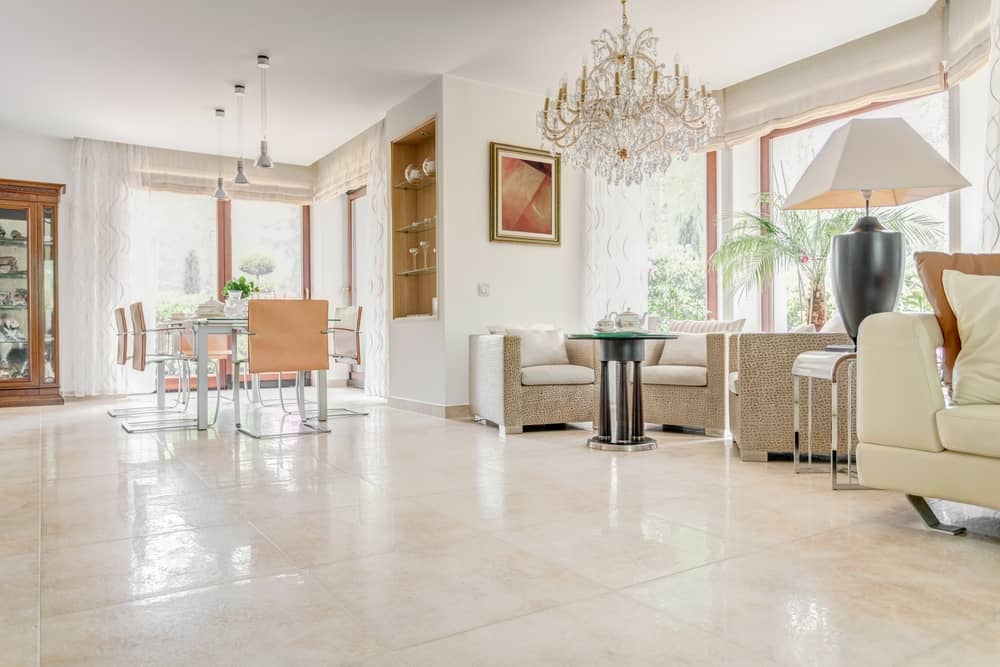Tiles are an excellent choice for flooring: They are durable, look fantastic, and last a lifetime.
Just like any other part of your home, once-shiny tiles can lose their lustre as they’re used.
Cleaning tile floors is simple and straightforward — and thankfully, so is polishing them.
You only need proper maintenance and the right polishing technique to get tile floors and walls shining again.
Polishing Ceramic Tiles | Polishing Porcelain Tiles | Polishing Glass Tiles | Polishing Marble Tiles | Polishing Stone Tiles | Polishing Wood Tiles | Polishing Wood-Look Tiles
Is Buffing Different From Polishing?
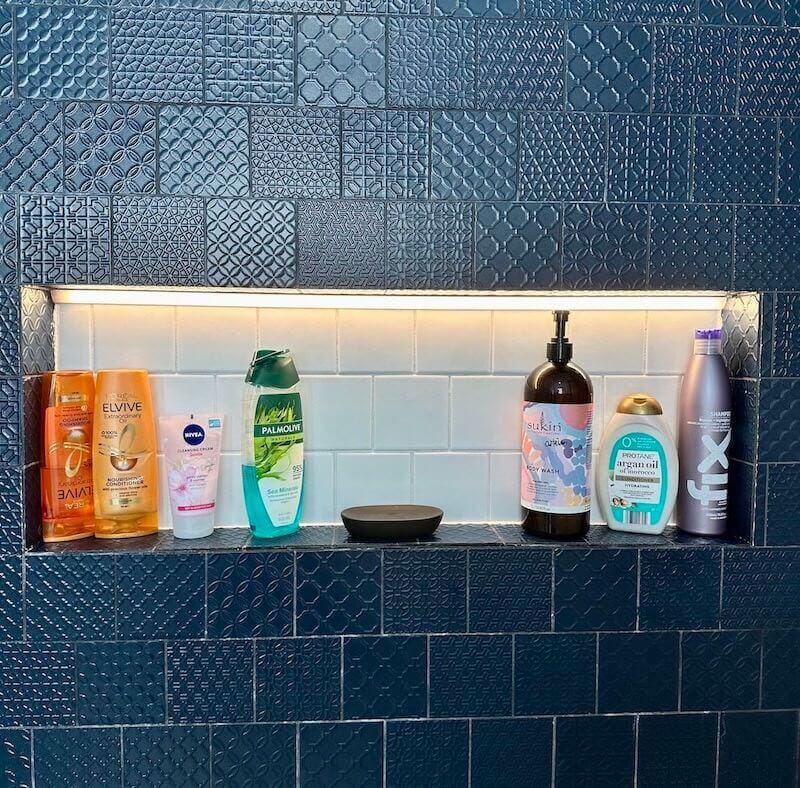
Buffing and polishing often get used interchangeably, but there’s a distinct difference.
Buffing generally refers to using a cloth or buffer pad to smooth out any imperfections and prepare the tile surface.
On the other hand, polishing involves using a product or substance that creates a shiny surface on your tiles.
So, do you buff or polish tiles first?
Buff first! Using skincare as an analogy, think of buffing as “serum” for tile floors and polishing as “moisturiser”.
Buffing makes tiles clean and shiny and can get rid of scum on the top layer of your tiles.
Both are great for your tiles, but sometimes, you won’t even need to repolish your tiles to get them gleaming again.
What Materials Do I Need to Polish Tiles?
There are so many commercial tile polishers available — but you can just use the following:
- A microfiber mop
- A clean microfiber cloth
- Tile-specific polishing cleaning solution (e.g., wood floor polish for wooden tiles)
- White vinegar
- Mild detergent
- Soft bristle brush
- Buffing pad
- A large bucket of clean, warm water
How to Polish Ceramic Tiles

Ceramic tiles are popular for their durability and ease of maintenance.
They’re highly durable and versatile and look great in any room.
They differ from porcelain tiles in terms of density (porcelain is denser), water absorption (porcelain absorbs less moisture), and finish (porcelain tiles are almost always glazed).
Beyond keeping them clean, getting ceramic tiles polished and gleaming goes a long way to enhancing the appearance of your tiles and your room.
Step 1: Clean the surface
Mix 1/4 cup white vinegar with 3 litres of water to create a DIY cleaning solution in your bucket.
If your tiles are particularly dirty, you can increase to 1/2 cup of white vinegar.
Using a microfiber mop, gently clean the tiles with a circular motion.
Make sure you clean the dirty grout as well!
NOTE: Avoid soap-based cleaners as these could leave residue on your tiles, dulling their shine!
Step 2: Buff with a microfiber pad
When you’re done mopping the ceramic tile floors, take the microfiber cloth and buff the tiles to get that shine.
Of course, if you have a buffing machine, you can use it with a white polishing pad.
Start at one corner of the room and work your way towards the exit, moving the machine in a side-to-side motion.
Overlap each pass slightly so you don’t miss any spots.
Step 3: Polish to shine
Once you’re done polishing the ceramic tiles, prepare a homemade polishing solution.
You can use one part white vinegar, three parts water and a few drops of dish detergent.
Use a clean microfiber cloth and go over the tiles again using the white vinegar solution.
Then wipe down the floor with another clean cloth. This can add a more polished finish to your tiles.
How to Polish Porcelain Tiles
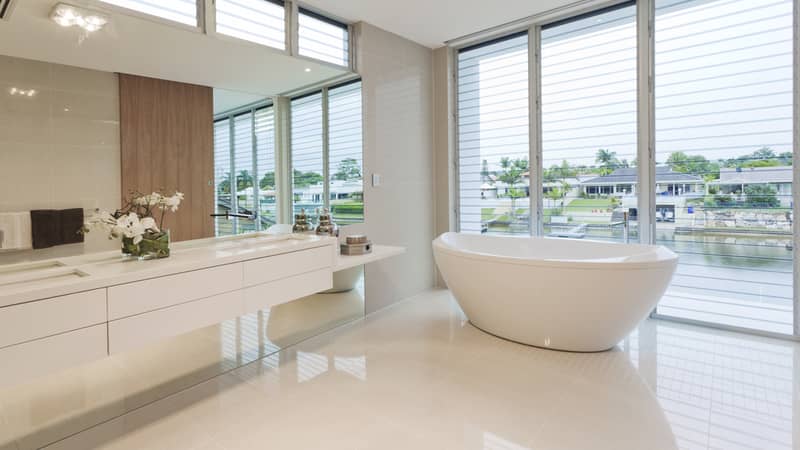
Polished porcelain tiles make any room look classy!
There are different types of porcelain tiles — glazed, textured, and unpolished.
They all have similar cleaning solutions; textured tile needs some extra scrubbing to get into those grooves and edges.
Step 1: Clean the tile floor
Mix 1/8 cup vinegar to 3 litres of water, as porcelain requires a mild cleaning solution.
Alternatively, you could use a pH-neutral cleaning product.
Mop the whole floor in sections, taking care to cover the entire tile each time.
Remember to clean the tile grout, too!
NOTE: Do not use soapy water to clean porcelain tiles — this could leave residue and make them look dull.
Step 2: Dry the porcelain tiles
Dry the tile floor with a clean microfibre cloth, or leave the room to dry with good ventilation.
You can prop a fan in the corner of the room and turn it on until the floor dries.
Step 3: Buff and polish ceramic tiles with microfiber
Buff the tile floors afterwards with a buffer or microfiber mop.
After completing all the steps, it’s time to admire your polished tile floor.
How to Polish Glass Tiles
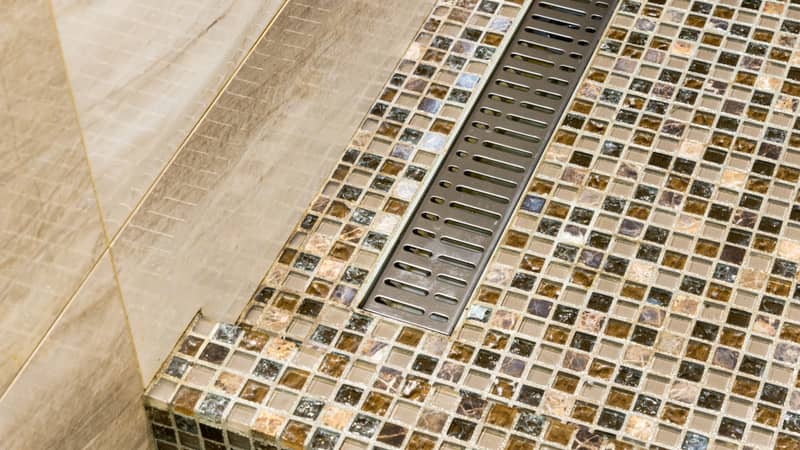
Glass tiles offer a unique and modern touch to spaces but can easily show scratches.
Step 1: Gently clean the glass tiles
Using lukewarm water with a splash of mild detergent, clean the tiles with a soft microfiber cloth.
Avoid using anything abrasive, such as a sponge or brush.
Step 2: Buff the entire floor
One of the easiest ways to get glass tiles sparkling is by mixing equal parts vinegar and water in a spray bottle.
Apply the mixture to the glass and let it sit for a few minutes.
Scrub tiles with a microfibre cloth or mop, then rinse with cold water.
Step 3: Use baking soda to get rid of stains
If your glass tiles have hard water stains, pour white vinegar on the surface and sprinkle some baking soda.
Then buff it with gentle circular motions and rinse to get a streak-free finish.
How to Polish Marble Tiles
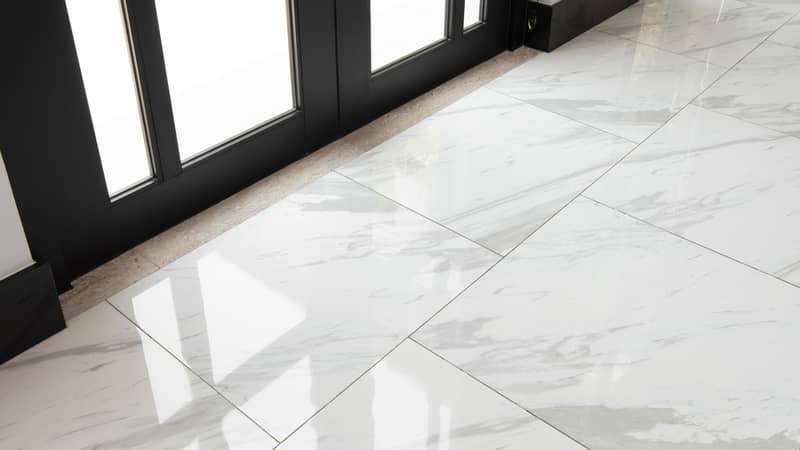
Marble exudes luxury, but it’s also sensitive and requires particular care.
Do not use polish or commercial cleaners on your marble floor unless it’s specifically made for marble.
Step 1: Clean using mild dish soap
Clean the marble tiles with a pH-neutral soap and water solution.
You can also use a soft bristle brush to lift and remove ingrained dirt.
Step 2: Use baking soda and water
Make a paste of equal parts bicarb soda and water, then spread it gently over the marble.
Let it dry, then wipe off the residue with a soft, clean rag and water.
Step 3: Buff with a microfiber cloth
Polish can damage marble tiles because it is a delicate material.
Plus, using polish on marble tile flooring can make the floor a slipping hazard.
Instead, use a dry microfibre or chamois cloth to buff the floor after cleaning.
How to Polish Stone Tiles

Granite and slate are the most popular choices for stone tiles.
Avoid using vinegar or soapy water when polishing stone tiles as these could damage your tiles in the long run.
Instead, the key to getting shiny granite floors is right in your kitchen—bicarb soda (aka baking soda)!
Step 1: Prepare your cleaning materials
Before you start buffing, fill a bucket with water so you can clean your rag in between polishes.
Mix 1/4 cup bicarb soda with 3 cups of water to create a cleaning mixture.
Step 2: Clean and polish your stone tile flooring
Apply the solution to the floor, then wipe it clean.
Put some elbow grease into it to buff the tile and make it shine.
Remember to buff gently!
Each stone has its tolerance, so always start slowly and increase pressure if necessary.
Step 3: Dry the floor
Follow with a dry cloth to remove any residue and dry the granite—you don’t want water seeping into your tile!
NOTE: Check your tiles for cracks or chips while buffing! If you find any, it’s highly recommended to replace the tile immediately or else it risks breaking.
How to Polish Wood Tile Floors

Wood tiles need specialised maintenance.
A vinegar solution could stain your wood tile and cause discolouration, while soapy water could seep through and cause warping.
Instead, opt for wood floor polish that suits the type of wood floor and finish you have.
Step 1: Prepare the tile floors
The thing about wood flooring is that it can be easily scratched by debris.
So, sweep or use a vacuum with soft rollers before polishing wooden tiles.
This helps prevent scratches and maintains the tile’s finish.
Step 2: Use a wood polish for hardwood tiles
Before polishing, check that the floor is thoroughly clean and dry.
Now, you can start by pouring a small amount of wood polish on the floor in an S pattern.
Using a flat microfiber mop, smooth the solution over the floor in the direction of the wood grain.
Work in small areas so you can better control the amount of force you use and the amount of polish you apply.
Remember, don’t press too hard — a little bit of pressure is enough!
Step 3: Dry your wooden tiles
Allow the wood polish to dry according to the product’s guidelines.
Remember, wood can’t be left wet or damp because it can swell and become deformed.
How to Polish Wood-Look Tiles
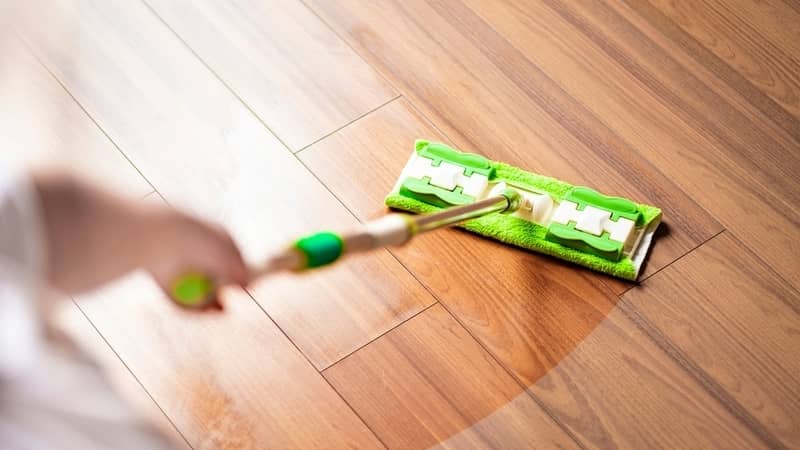
Wood-like tiles are typically ceramic or porcelain with a faux wood finish.
This type of tile demands a combination of gentle cleaning and periodic polishing to maintain its lustre.
Step 1: Dust and sweep your wood-like tiles
Remove surface dust with a soft broom or vacuum cleaner with a tile-friendly attachment.
Step 2: Mop and clean the wood-like tile floors
Use a flat microfiber mop with a mixture of mild detergent and warm water.
Be sure to wring out excess water to avoid over-wetting the tiles.
Step 3: Polish wood-look tiles
Since some wood tile floors are not real wood, you should avoid using wood polishes.
Instead, opt for a tile and laminate polish that provides a shine without making the floor slippery.
If you have ceramic or porcelain wood-look tiles, you can use a mix of one part vinegar and three parts water.
Typically, you’ll apply a small amount of the floor polish on a clean, soft cloth or mop.
Work in small sections, applying the polish in a thin, even layer.
Step 4: Dry the floor
Allow the polish to dry according to the manufacturer’s instructions.
Some products require a certain drying period before the floor can be walked on.
Generally, wait at least one hour before allowing people back into the room.
Wait a full day before replacing any furniture.
Post-Polishing Tile Maintenance Tips
Beyond getting your tiles to shine, it’s important to maintain them so they last longer.
It doesn’t matter whether you’ve changed your tiles for home improvement or kept the same tiles for years.
If they’re not cleaned and polished, they won’t serve you well.
Remove grout haze
If your tiles are newly-installed, you’ll want to remove grout haze before doing any buffing or cleaning.
Cleaning new tiles after installation is important to tidy up your floor, especially since grout residue can smudge or scratch your tile.
Regular cleaning
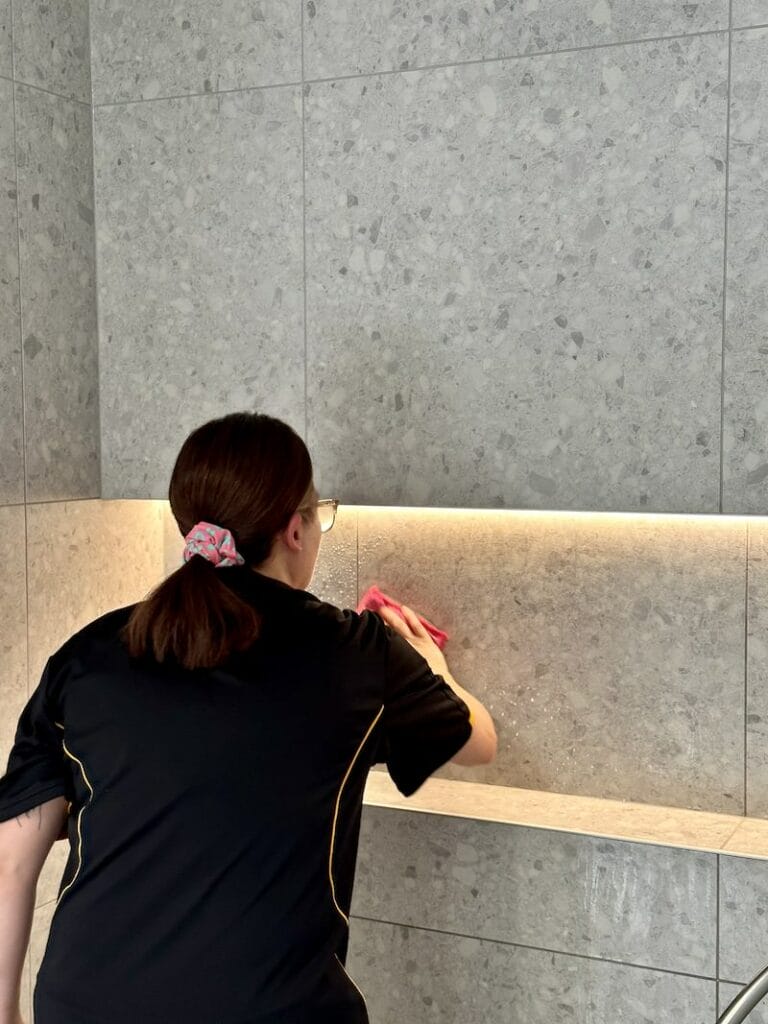
Sweeping and mopping frequently go a long way to maintaining a tile floor.
Floors should be swept or vacuumed at least once a week and mopped at least once a month.
For bathrooms, deep clean your tiles once a week, too.
One more thing, don’t forget to clean the tile grout!
Avoid abrasives
Do not use abrasive sponges for porcelain, ceramic, granite, marble, and glass tiles.
You risk scratching or smudging your surface and can’t clean that away.
Place felt gliders and other padding underneath rooms with furniture to prevent scuffing.
Minimise dirt
Place door mats at strategic entrances for people to dust off their shoes before entering the house.
Keep a clean rag or mat in the kitchen while you’re cooking.
The less dirt that gets on your floors, the easier cleaning tiles becomes — and polishing tiles, too!
Tile to Say Goodbye to Dull Floors
Home improvement starts from the floor up.
Polishing your tiles can drastically change the appearance of your space.
If you ever feel overwhelmed by the task, call a house cleaning professional to have your tiles looking their best.

